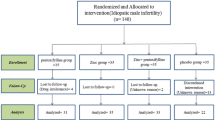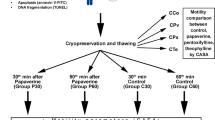Abstract
Objective
To determine the safety and efficacy of oral pentoxifylline (PTX) administration in improving semen parameters in infertile men with idiopathic OAT.
Patients and methods
The study included 254 infertile men who underwent double-blind therapy with 400 mg PTX (Apotex Inc., Toronto, Canada) twice daily (group 1, n = 127), or similar regimen of placebo (group 2, n = 127). The study consisted of a 4-week screening phase, a 24-week treatment phase, and a 12-week treatment-free period. The effects of treatment on semen parameters, serum hormones including testosterone, luteinizing hormone (LH), follicle-stimulating hormone (FSH) and inhibin B, seminal plasma catalase-like and superoxide dismutase (SOD)-like activity, and acrosome reaction test were evaluated.
Results
A significant increase in sperm concentration (mean value, 26.4 ± 4.6 × 106/ml vs. 16.2 ± 3.4 × 106/ml), sperm motility (mean value, 35.8 ± 4.2% vs. 26.4 ± 2.4%), and sperm with normal morphology (mean value, 25.4 ± 4.3% vs. 17.4 ± 4.2%) was observed after PTX administration when compared with baseline (all P = 0.001); in contrast, a subtle decreased values were observed after placebo (median values, 16.4 ± 4.1 × 106/ml vs. 16.7 ± 3.6 × 106/ml, P = 0.1; 25.7 ± 3.6% vs. 26.8 ± 2.5%, P = 0.08; and 16.9 ± 4.1% vs. 17.6 ± 4.4%, P = 0.08, respectively). Mean SOD-like and catalase-like activity in the semen of PTX group was significantly greater than in the semen of placebo group (46.4 ± 2.4 vs. 36.3 ± 1.3 U/ml and 371 ± 44 vs. 301 ± 14 U/ml, respectively, both P = 0.003). The acrosome reaction was observed to be increased in PTX group (P = 0.01). Levels of reproductive hormones were also affected.
Conclusions
PTX administration significantly improves semen parameters in infertile men with idiopathic OAT.




Similar content being viewed by others
References
de Kretser DM (1997) Male infertility. Lancet 349:787–790
Safarinejad MR (2008) Infertility among couples in a population-based study in Iran: prevalence and associated risk factors. Int J Androl 31:303–314
Brugh VM III, Lipshultz LI (2004) Male factor infertility: evaluation and management. Med Clin North Am 88:367–385
Eugster A, Vingerhoets AJJM (1999) Psychological aspects of in vitro fertilization: a review. Soc Sci Med 48:557–559
Collins J (2002) An international survey of the health economics of IVF and ICSI. Hum Reprod Update 8:265–277
Serour GI (2008) Medical and socio-cultural aspects of infertility in the Middle East. Hum Reprod 1:34–41
Serour GI (2002) Attitudes and cultural perspectives on infertility and its alleviation in the Middle East area. In: Vayena E, Rowe PJ, Griffin PD (eds) Current practices and controversies in assisted reproduction. World Health Organization, Geneva, pp 41–49
Kumar R, Gautam G, Gupta NP (2006) Drug therapy for idiopathic male infertility: rationale versus evidence. J Urol 176:1307–1312
Heller CG, Nelson WO, Hill IB et al (1950) Improvement in spermatogenesis following depression of the human testis with testosterone. Fertil Steril 1:415–422
Clark RV, Sherins RJ (1989) Treatment of men with idiopathic oligozoospermic infertility using the aromatase inhibitor, testolactone. Results of a double-blinded, randomized, placebo-controlled trial with crossover. J Androl 10:240–247
Gross KM, Matsumoto AM, Berger RE et al (1986) Increased frequency of pulsatile luteinizing hormone releasing hormone administration selectively decreases follicle-stimulating hormone levels in men with idiopathic azoospermia. Fertil Steril 45:392–396
Vandekerckhove P, Lilford R, Vail A et al (2000) Clomiphene or tamoxifen for idiopathic oligo/asthenospermia. Cochrane Database Syst Rev 2:CD000151
Palan P, Naz R (1996) Changes in various antioxidant levels in human seminal plasma related to immunoinfertility. Arch Androl 36:139–143
Keskes-Ammar L, Feki-Chakroun N, Rebai T et al (2003) Sperm oxidative stress and the effect of an oral vitamin E and selenium supplement on semen quality in infertile men. Arch Androl 49:83–94
Lenzi A, Lombardo F, Sgrò P et al (2003) Use of carnitine therapy in selected cases of male factor infertility: a double blind cross-over trial. Fertil Steril 79:292–300
Safarinejad MR, Safarinejad S (2009) Efficacy of selenium and/or N-acetyl-cysteine for improving semen parameters in infertile men: a double-blind, placebo controlled, randomized study. J Urol 181:741–751
Safarinejad MR (2009) Efficacy of coenzyme Q10 on semen parameters, sperm function and reproductive hormones in infertile men. J Urol 182:237–248
Safarinejad MR (2010) Effect of omega-3 polyunsaturated fatty acid supplementation on semen profile and enzymatic anti-oxidant capacity of seminal plasma in infertile men with idiopathic oligoasthenoteratospermia: a double-blind, placebo-controlled, randomised study. Andrologia 41:1–10
Tesarik J, Mendoza C, Carreras A (1992) Effect of phosphodiesterase inhibitors, caffeine and pentoxifylline, on spontaneous and stimulus-induced acrosome reactions in human sperm. Fertil Steril 58:185–190
Garbers DL, Lust WD, First NL et al (1971) Effect of phosphodiesterase inhibitors and cyclic nucleotides on sperm respiration and motility. Biochemistry 10:1825–1831
Nassar A, Mahony M, Morshedi M et al (1999) Modulation of sperm tail protein tyrosine phosphorylation by pentoxifylline and its correlation with hyperactivated motility. Fertil Steril 71:919–923
Oliva A, Dotta A, Multigner L (2009) Pentoxifylline and antioxidants improve sperm quality in male patients with varicocele. Fertil Steril 91(4 Suppl):1536–1539
Laokirkkiat P, Kunathikom S, Choavaratana R et al (2007) Comparison between sperm treated with pentoxifylline and 2-deoxyadenosine using hypo-osmotic swelling test. J Med Assoc Thai 90:211–215
Maxwell DT, Jacobson JD, King A et al (2002) Effect of pentoxifylline on tumor suppressor and proto-oncogene apoptosis in sperm. J Assist Reprod Genet 19:279–283
Terriou P, Hans E, Giorgetti C et al (2000) Pentoxifylline initiates motility in spontaneously immotile epididymal and testicular spermatozoa and allows normal fertilization, pregnancy, and birth after intracytoplasmic sperm injection. J Assist Reprod Genet 17:194–199
Faka B, Api M, Fiçicioğlu C et al (1994) Pentoxifylline in male-factor infertility: its therapeutic efficacy after oral administration. Acta Eur Fertil 25:351–353
World Health Organization (1999) WHO laboratory manual for the examination of human semen, sperm-cervical mucus interaction, 4th edn. Cambridge University Press, Cambridge
Zini A, Fischer MA, Mak V et al (2002) Catalase-like and superoxide dismutase-like activities in human seminal plasma. Urol Res 30:321–323
Yeung CH, De Geyter C, De Geyter M et al (1996) Production of reactive oxygen species by and hydrogen peroxide scavenging activity of spermatozoa in an IVF program. J Assist Reprod Genet 13:495–500
Garde JJ, Ortiz N, Garcia A et al (1997) Use of triple-stain technique to detect viability and acrosome reaction in deer spermatozoa. Arch Androl 39:1–9
Aitken RJ, Clarkson JS (1987) Cellular basis of defective sperm function and its association with the genesis of reactive oxygen species by human spermatozoa. J Reprod Fertil 81:459–469
Kovacic B, Vlaisavljevic V, Reljic M (2006) Clinical use of pentoxifylline for activation of immotile testicular sperm before ICSI in patients with azoospermia. J Androl 27:45–52
Merino G, Martínez Chéquer JC, Barahona E et al (1997) Effects of pentoxifylline on sperm motility in normogonadotropic asthenozoospermic men. Arch Androl 39:65–69
Marrama P, Baraghini GF, Carani C et al (1985) Further studies on the effects of pentoxifylline on sperm count and sperm motility in patients with idiopathic oligo-asthenozoospermia. Andrologia 17:612–616
Malachi T, Bichachu S, Halbrecht I (1982) Prostaglandins and cyclic-AMP in human semen. Prostaglandins Leukot Med 8:55–62
Ahmad MK, Mahdi AA, Shukla KK et al (2008) Effect of Mucuna pruriens on semen profile and biochemical parameters in seminal plasma of infertile men. Fertil Steril 90:627–635
Lefievre L, Jha KN, de Lamirande E et al (2002) Activation of protein kinase A during human sperm capacitation and acrosome reaction. J Androl 23:709–716
Osheroff JE, Visconti PE, Valenzuela JP et al (1999) Regulation of human sperm capacitation by a cholesterol efflux-stimulated signal transduction pathway leading to protein kinase A-mediated up-regulation of protein tyrosine phosphorylation. Mol Hum Reprod 5:1017–1026
Saleh R, Agarwal A (2002) Oxidative stress and male infertility: from research bench to clinical practice. J Androl 23:737–752
Aitkin RJ, West K, Buckingham DW (1994) Leukocytic infiltration into the human ejaculate and its association with sperm quality, oxidative stress and sperm function. J Androl 15:343–352
Comhaire FH, Mahmoud AM, Depuydt CE et al (1999) Mechanism and effects of male genital tract infection on sperm quality and fertilizing potential: the Andrologist’s view point. Hum Reprod Update 5:393–398
Zabel P, Wolter DT, Schonharting MM et al (1989) Oxpentifylline in endotoxemia. Lancet 2:1474–1477
Thanhäuser A, Reiling N, Böhle A et al (1993) Pentoxifylline: a potent inhibitor of IL-2 and IFN-gamma biosynthesis and BCG-induced cytotoxicity. Immunology 80:151–156
Sullivan GW, Carper HT, Novick WJ Jr et al (1988) Inhibition of the inflammatory action of interleukin-1 and tumor necrosis factor-alpha on neutrophil function by pentoxifylline. Infect Immunol 56:1722–1729
Crouch SP, Fletcher J (1992) Effect of ingested pentoxifylline on neutrophil superoxide anion production. Infect Immun 60:4504–4509
D’Hellencourt CL, Diaw L, Cornillet P et al (1996) Differential regulation of TNF alpha, IL-1 beta, IL-6, IL-8, TNF beta, and IL-10 by pentoxifylline. Int J Immunopharmacol 18:739–748
Hammerman C, Goldschmidt D, Caplan MS et al (1999) Amelioration of ischemia-reperfusion injury in rat intestine by pentoxifylline-mediated inhibition of xantine oxidase. J Pediatr Gastroenterol Nutr 29:69–74
Cross AR, Jones OT (1991) Enzymic mechanisms of superoxide production. Biochim Biophys Acta 1057:281–298
Bilsborough W, O’Driscoll G, Stanton K et al (2002) Effect of lowering tumor necrosis factor-alpha on vascular endothelial function in type 2 diabetes. Clin Sci (Lond) 103:163–169
Jackson MJ, Papa S, Bolaños J et al (2002) Antioxidants, reactive oxygen and nitrogen species, gene induction and mitochondrial function. Mol Aspects Med 23:209–285
Keskes-Ammar L, Feki-Chakroun N, Rebai T et al (2003) Sperm oxidative stress and the effect of an oral vitamin E and selenium supplement on semen quality in infertile men. Arch Androl 49:83–94
Lenzi A, Culasso F, Gandini L et al (1993) Placebo-controlled, double blind, cross-over trial of glutathione therapy in male infertility. Hum Reprod 8:1657–1662
Costa M, Canale D, Filicori M et al (1994) L-Carnitine in idiopathic asthenozoospermia: a multicenter study. Andrologia 26:155–159
Oates RD, Silber S, Brown LG et al (2002) Clinical characterization of 42 oligospermic or azoospermic men with microdeletion of the AZFc region of the Y chromosome, and of 18 children conceived via ICSI. Hum Reprod 17:2813–2824
Hansen M, Kurinczuk JJ, Bower C et al (2002) The risk of major birth defects after intracytoplasmic sperm injection and in vitro fertilization. N Engl J Med 346:725–730
Acknowledgments
The authors thank all the participants for their enthusiastic cooperation, which made this study clinically and scientifically relevant. The authors wish to thank Shiva Safarinejad and Nayyer Shafiei for their excellent technical assistance and Saba Safarinejad for her advice regarding collection and statistical evaluation of data.
Conflict of interest
None.
Author information
Authors and Affiliations
Corresponding author
Rights and permissions
About this article
Cite this article
Safarinejad, M.R. Effect of pentoxifylline on semen parameters, reproductive hormones, and seminal plasma antioxidant capacity in men with idiopathic infertility: a randomized double-blind placebo-controlled study. Int Urol Nephrol 43, 315–328 (2011). https://doi.org/10.1007/s11255-010-9826-4
Received:
Accepted:
Published:
Issue Date:
DOI: https://doi.org/10.1007/s11255-010-9826-4




